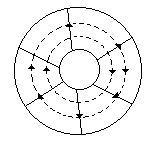ECE :: Microwave Communication
-
A coaxial RF cable has a characteristic impedance of 50 Ω and C equal to 40 pF/m. The inductance is
-
In a microwave coaxial line, the maximum operating frequency is f max and breakdown strength of dielectric is Ed' Then maximum power handling capacity is proportional to
-
To couple a coaxial line to a parallel wire line it is best to use
-
In a multicavity klystron amplifier the signal to be amplified develops an ac voltage of signal frequency across the gap in buncher cavity
-
If VSWR is infinite, the transmission line is terminated in
-
The number of TV channels which can be accommodated in a spectrum of 300 MHz is about
-
Assertion (A): The velocity of electromagnetic waves on overhead lines and coaxial cables is the same.
Reason (R): Free space has an intrinsic impedance of 377 ohms.
-
In the given figure the E and H lines in a coaxial cable



 Whatsapp
Whatsapp
 Facebook
Facebook


 .
.



 and
and  . Since VSWR = ∞, |
. Since VSWR = ∞, |